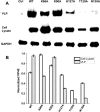A loop region in the N-terminal domain of Ebola virus VP40 is important in viral assembly, budding, and egress
- PMID: 25330123
- PMCID: PMC4213565
- DOI: 10.3390/v6103837
A loop region in the N-terminal domain of Ebola virus VP40 is important in viral assembly, budding, and egress
Abstract
Ebola virus (EBOV) causes viral hemorrhagic fever in humans and can have clinical fatality rates of ~60%. The EBOV genome consists of negative sense RNA that encodes seven proteins including viral protein 40 (VP40). VP40 is the major Ebola virus matrix protein and regulates assembly and egress of infectious Ebola virus particles. It is well established that VP40 assembles on the inner leaflet of the plasma membrane of human cells to regulate viral budding where VP40 can produce virus like particles (VLPs) without other Ebola virus proteins present. The mechanistic details, however, of VP40 lipid-interactions and protein-protein interactions that are important for viral release remain to be elucidated. Here, we mutated a loop region in the N-terminal domain of VP40 (Lys127, Thr129, and Asn130) and find that mutations (K127A, T129A, and N130A) in this loop region reduce plasma membrane localization of VP40. Additionally, using total internal reflection fluorescence microscopy and number and brightness analysis we demonstrate these mutations greatly reduce VP40 oligomerization. Lastly, VLP assays demonstrate these mutations significantly reduce VLP release from cells. Taken together, these studies identify an important loop region in VP40 that may be essential to viral egress.
Figures









Similar articles
-
ALIX Rescues Budding of a Double PTAP/PPEY L-Domain Deletion Mutant of Ebola VP40: A Role for ALIX in Ebola Virus Egress.J Infect Dis. 2015 Oct 1;212 Suppl 2(Suppl 2):S138-45. doi: 10.1093/infdis/jiu838. Epub 2015 Mar 18. J Infect Dis. 2015. PMID: 25786915 Free PMC article.
-
Non-active site mutations disturb the loop dynamics, dimerization, viral budding and egress of VP40 of the Ebola virus.Mol Biosyst. 2017 Feb 28;13(3):585-597. doi: 10.1039/c6mb00803h. Mol Biosyst. 2017. PMID: 28170013
-
Minor electrostatic changes robustly increase VP40 membrane binding, assembly, and budding of Ebola virus matrix protein derived virus-like particles.J Biol Chem. 2024 May;300(5):107213. doi: 10.1016/j.jbc.2024.107213. Epub 2024 Mar 24. J Biol Chem. 2024. PMID: 38522519 Free PMC article.
-
The Role of Exosomal VP40 in Ebola Virus Disease.DNA Cell Biol. 2017 Apr;36(4):243-248. doi: 10.1089/dna.2017.3639. Epub 2017 Feb 8. DNA Cell Biol. 2017. PMID: 28177658 Free PMC article. Review.
-
Membrane binding and bending in Ebola VP40 assembly and egress.Front Microbiol. 2014 Jun 18;5:300. doi: 10.3389/fmicb.2014.00300. eCollection 2014. Front Microbiol. 2014. PMID: 24995005 Free PMC article. Review.
Cited by
-
Curcumin and Natural Derivatives Inhibit Ebola Viral Proteins: An In silico Approach.Pharmacognosy Res. 2017 Dec;9(Suppl 1):S15-S22. doi: 10.4103/pr.pr_30_17. Pharmacognosy Res. 2017. PMID: 29333037 Free PMC article.
-
Ebolavirus comparative genomics.FEMS Microbiol Rev. 2015 Sep;39(5):764-78. doi: 10.1093/femsre/fuv031. Epub 2015 Jul 14. FEMS Microbiol Rev. 2015. PMID: 26175035 Free PMC article. Review.
-
Mechanisms of phosphatidylserine influence on viral production: A computational model of Ebola virus matrix protein assembly.J Biol Chem. 2022 Jul;298(7):102025. doi: 10.1016/j.jbc.2022.102025. Epub 2022 May 11. J Biol Chem. 2022. PMID: 35568195 Free PMC article.
-
Cheminformatics-Based Study Identifies Potential Ebola VP40 Inhibitors.Int J Mol Sci. 2023 Mar 27;24(7):6298. doi: 10.3390/ijms24076298. Int J Mol Sci. 2023. PMID: 37047270 Free PMC article.
-
The Ebola Virus matrix protein, VP40, requires phosphatidylinositol 4,5-bisphosphate (PI(4,5)P2) for extensive oligomerization at the plasma membrane and viral egress.Sci Rep. 2016 Jan 12;6:19125. doi: 10.1038/srep19125. Sci Rep. 2016. PMID: 26753796 Free PMC article.
References
-
- Feldmann H. Ebola—A growing threat? N. Engl. J. Med. 2014;371:1375–1378. - PubMed
Publication types
MeSH terms
Substances
Grants and funding
LinkOut - more resources
Full Text Sources
Other Literature Sources
Medical

